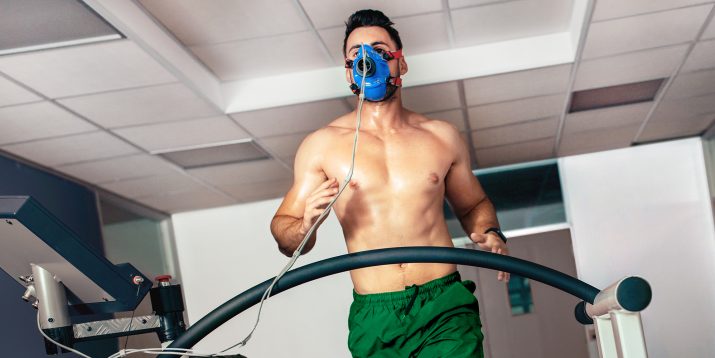What Is VO2 Max, and How Does It Affect Your Fitness?

There’s no shortage of ways to measure fitness, but which method is the most accurate? Body mass index (BMI), waist circumference, and the numbers on the scale can help track weight loss and offer clues to your overall health, but none of them provide a reliable measurement of cardiorespiratory fitness, which, according to the American Heart Association, is one of the strongest indicators of overall health. That’s why top health and fitness professionals advocate VO2 max testing.
What is VO2 Max?
VO2 max is the measure of your body’s efficiency in consuming and utilizing oxygen. If that sounds complicated, perhaps a broader view of cardiorespiratory system functions and the blood oxygenation process is in order.
In simple terms, we inhale oxygen into our lungs, where it’s transferred to our blood. The oxygenated blood travels to the heart, where it’s pumped out to the body’s organs, muscles, and various other tissues.
VO2 max represents the greatest volume of oxygen your body can recruit for that process in a given period of time. It’s measured in milliliters of oxygen per kilogram of bodyweight per minute, or ml/kg/min.
Besides being an indicator of cardiorespiratory fitness, a strong VO2 max can help you achieve your health and fitness goals.
“The more oxygen you can utilize, the longer you’ll be able to sustain high-intensity effort,” says Trevor Thieme, C.S.C.S.
“In practice, improving your VO2 max might translate into a new PR in a 10K or being able to push yourself harder in a HIIT workout.”
Limiting factors affecting VO2 max
VO2 max is determined by what are called central and peripheral factors, explains USA Track & Field certified coach Jason Karp, Ph.D.
Central factors include supply side functions like blood flow and cardiac output (i.e., the amount of blood pumped by the heart per minute).
Peripheral factors represent the demand side, and include the amount of oxygen that muscles can extract from the blood for use.
“While unfit people seem to be equally limited by central and peripheral factors (they lack both a high blood flow and abundant metabolic machinery), highly trained runners seem to be more centrally limited,” says Karp.
Basically, he explains, as you become fitter, everything (heart, lungs, vascular system, and muscles) becomes more efficient at processing, delivering, and extracting oxygen. But there comes a point at which your muscles’ ability to extract oxygen outpaces your heart and lungs’ ability to deliver it.
How is VO2 Max measured?

According to Karp, the best way to measure VO2 max is in a lab using indirect calorimetry, a test that requires the subject to run or bike at maximal effort while wearing a face mask connected to an oxygen analyzer. As the subject sprints or pedals, the equipment measures the volume of oxygen consumed.
What about wearables? Does the VO2 max function on your fitness tracker or running watch actually work?
“Watches and wearable tech will not give someone a [truly accurate] reading because there’s no way that technology can measure how much oxygen one consumes when running or biking as fast as one can,” says Karp.
However, he adds they can offer a rough estimate and a baseline for improving your cardiorespiratory fitness.
How to Increase VO2 Max
If you’re new to exercising and want to improve your VO2 max, first focus on increasing the volume of aerobic training you do. If you’re a runner, that means trying to increase your weekly mileage.
Once you’ve established a solid foundation of cardiorespiratory fitness, shift your focus to also include increasing exercise intensity.
“To increase your VO2 max, you have to exercise at intensities that meet or exceed your lactate threshold, which you’ll hit at about 80 to 85 percent of your maximum heart rate,” says Thieme. In short, start doing shorter, fast-paced workouts. One way to do that is through high-intensity interval trailing (HIIT).
What Is a Good VO2 Max Number?
VO2 max rates vary by age (they tend to be higher in younger populations) and sex.
“Men have a higher VO2 max than women because they have a greater cardiac output to send more blood and oxygen to the muscles, more hemoglobin in their blood to transport oxygen, and more muscle mass to consume oxygen,” says Karp.
So, yes, men are literally sucking up more of the oxygen in the room. While elite male athletes can have a VO2 max of more than 70 ml/kg/min, the rates for most adults in fair to excellent shape fall between 20 and 55 ml/kg/min. Use the table below for healthy VO2 max ranges in your demographic.
| AGE | MEN | WOMEN |
| 20-29 | 47.6 ml/kg/min (+/- 11.3) | 37.6 ml/kg/min (+/- 10.2) |
| 30-39 | 43.0 ml/kg/min (+/- 9.9) | 30.9 ml/kg/min (+/- 8.0) |
| 40-49 | 38.8 ml/kg/min (+/- 9.6) | 27.9 ml/kg/min (+/- 7.7) |
| 50-59 | 33.8 ml/kg/min (+/- 9.1) | 24.2 ml/kg/min (+/- 6.1) |
| 60-69 | 29.4 ml/kg/min (+/- 7.9) | 20.7 ml/kg/min (+/- 5.0) |
| 70-79 | 25.8 ml/kg/min (+/- 7.1) | 18.3 ml/kg/min (+/- 3.6) |
| All | 37.8 ml/kg/min (+/- 11.1) | 27.6 ml/kg/min (+/- 9.1) |
